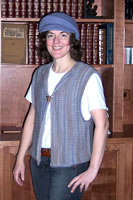 Three Mirror Vest
Three Mirror Vest
Hand knit version. A very similar machine knit version is available here.Completed Jan 12, 2005
This page has a generator to create a pattern for a simple hand knit vest. It's a fairly easy generator to use, and a very easy pattern. I've named the "Three Mirror Vest" because you mirror the shaping at 3 different points.
Features of this design pattern:
- Cast on at center front.
- Knit back and forth. I knit on Denise circular knitting needles, but you can use straight knitting needles.
- Stockinette body.
- Garter stitch trim.
- Front closed with a decorative pin. (You could knit I-Cord ties to close.)
- Generator asks gauge before and after washing and blocking swatch. This is useful if you use a yarn that shrinks, or decide to felt the vest.
- Pattern generator has a pull down menu for a range of dress sizes, but you can also customize to the measurements you like.
- Looks especially nice in a variegated, or self striping, yarn.
I'm thinking of writing a pattern for a jacket based on this design.
I'll just pick up stitches at the armholes and knit sleeves. I'm
tempted to get a luxury cashmere merino blend yarn for total knitting
pleasure. But, cotton would be nicer for spring! We'll see.
Lucia Liljegren
Visit
the whole site!
|
My site is supported by your annual $3 donation. Please click. |
|